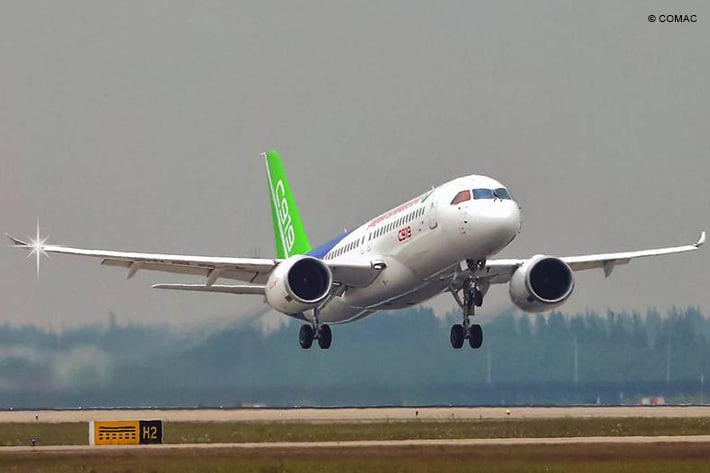Aerospace
China certifies C919 jet to compete with Airbus and Boeing
China certified its domestic C919 airplane. Pictures shared on social media demonstrated, marking a significant development in the nation’s goals to compete with Airbus (AIR.PA) and Boeing (BA.N) in the commercial aerospace sector.

On Thursday, China certified its domestic C919 airplane. Pictures shared on social media demonstrated, marking a significant development in the nation’s goals to compete with Airbus (AIR.PA) and Boeing (BA.N) in the commercial aerospace sector.
China’s Commercial Aircraft Corp. built this aircraft COMAC, being certified by the end of the month after two planes took off for Beijing on September 13 had been widely anticipated. ‘C919 airplane type certificate issuance ceremony’ was written in Chinese on a sign that was visible in one of the pictures.
COMAC C919 Successfully Completes Flight Tests(Opens in a new browser tab)
The C919, which was introduced 14 years ago and can accommodate up to 168 passengers, will face off against the well-liked Airbus A320neo and Boeing 737 MAX families in the second-largest aviation market in the world as China aims to boost its technological independence amid trade concerns.
Aircraft may built-in china heavily with western components is used, Like engines and Avionics. But China is pushing hard to inbuilt its own Engine which is in progress.
Although local media have stated that the jet is unlikely to begin commercial service with passengers until next year, the type of license awarded on Thursday allows it to be delivered to the first customer, China Eastern Airlines Corp Ltd.
Top 5 selling Narrow Body aircraft(Opens in a new browser tab)
It is unknown if the C919 will be on display or flown at the expo in November, which is the nation’s main aviation event. China will require an average of 300 narrowbody passenger aircraft like the C919 annually over the next 20 years.
Foreign Certification
In addition to the work being done by CAAC, the European Union Aviation Safety Agency (EASA) has been working for years on a certification validation process for the C919 with COMAC.
According to COMAC’s website, 28 customers have placed 815 orders for the C919 so far. But just one client, China Eastern, has made a firm delivery schedule announcement, and it anticipates only four deliveries in next year.
The Boeing 737 MAX, which has been grounded since March 2019 as a result of two catastrophic incidents, has not yet been used for commercial purposes in China.
China is also developing the wide-body Comac 929 aircraft. The C929 aircraft is being developed jointly by China and Russia, with testing possibly beginning in 2028.
The aircraft was listed in May 2022 for 653 million yuan (US$101 million), nearly matching the prices of the Airbus A320neo and Boeing 737 Max rivals and more than doubling the initial US$50 million price estimate.

Aerospace
When Ratan Tata was denied entry to the airfield at the Aero India show, he waited

During our visit to Aero India 2019, we had the unexpected opportunity to see Ratan Tata at the event, which was a thrilling moment for us. However, there was a surprising hiccup when the security staff didn’t allow him to enter due to a lack of a security pass.
Despite this, he remained calm and patiently waited for about 20 minutes until a member of the Tata team brought him the required pass, after which he calmly proceeded inside. It was a humbling sight, showcasing his composed demeanor even in such situations.
Ratan Tata ji is not only a renowned industrialist but also a trained pilot, holding a pilot’s license. In 2007, he became the first Indian civilian to fly the F-16 Falcon during the Aero India show in Bangalore—a proud moment for the nation.
His passion for aviation extended beyond flying, as he played a key role in shaping India’s aerospace industry. Under his leadership, Tata ventured into manufacturing and maintaining aerospace components while upholding its legacy of quality. Notably, Tata’s collaboration with Airbus to develop and manufacture the C295 aircraft is a testament to its growing influence in the sector.
-

 Aviation2 months ago
Aviation2 months agoMicrosoft Flight Simulator Raises $3 Million to Bring Back the An-225 Mriya
-

 Airlines2 months ago
Airlines2 months agoQatar Citizens Can Travel to the United States Without a Visa
-

 Aviation2 months ago
Aviation2 months agoQatar Airways bans these new Electronic Devices on plane
-

 Airlines2 months ago
Airlines2 months agoJapan Airlines Rolls Out Free Domestic Flights to International Passengers
-

 Defence2 months ago
Defence2 months agoWhich Country Has the Largest Fleet of Fighter Aircraft?
-

 Airport2 months ago
Airport2 months agoWestern Sydney Airport Welcomes Its First Plane After 6 Years of construction
-

 Airlines4 days ago
Airlines4 days agoDAMAC Air: Dubai’s New Luxury Airline Offers Free Flights for Registration
-

 Aviation2 months ago
Aviation2 months agoDid you know ? Once Boeing 747 carried 1088 passenger in 1991








